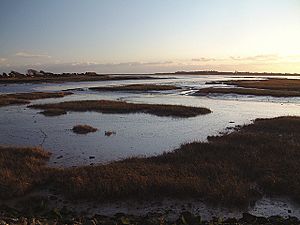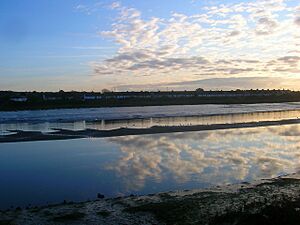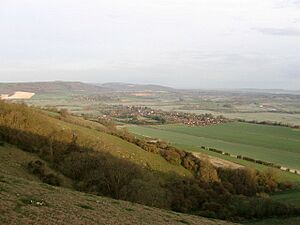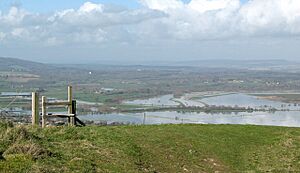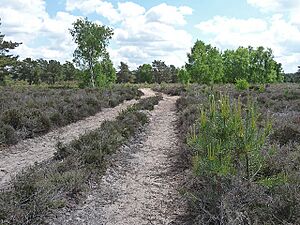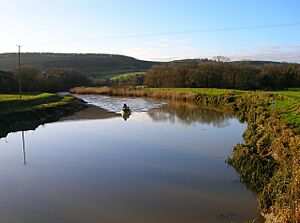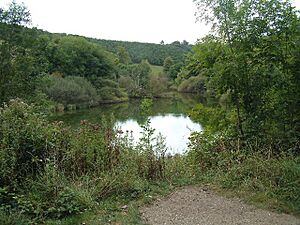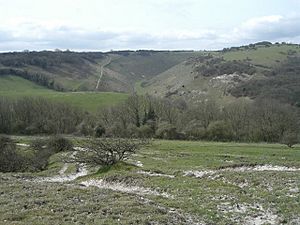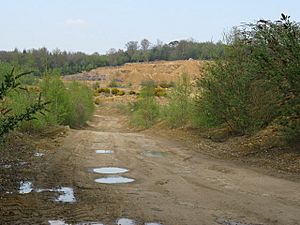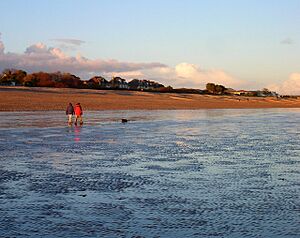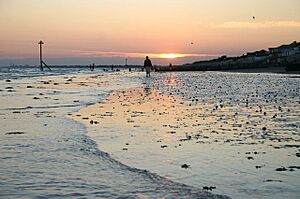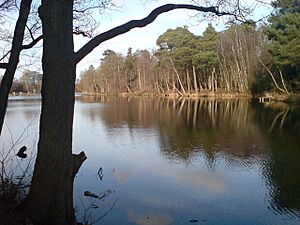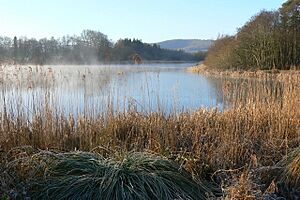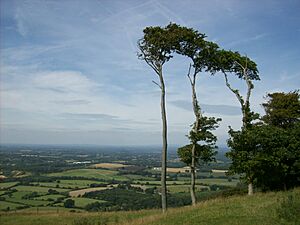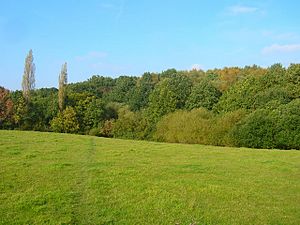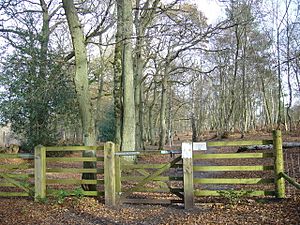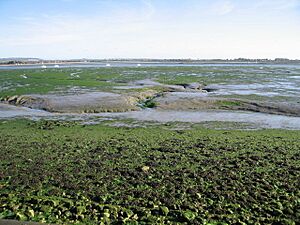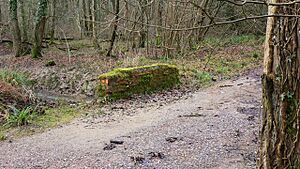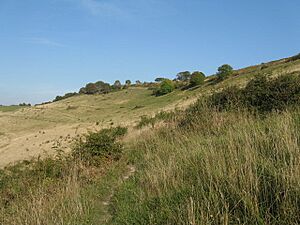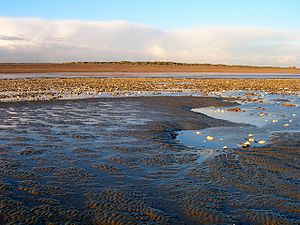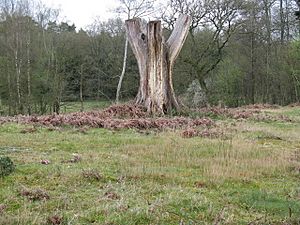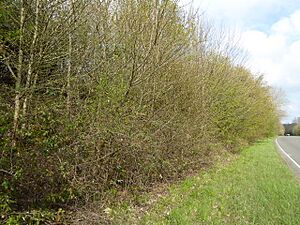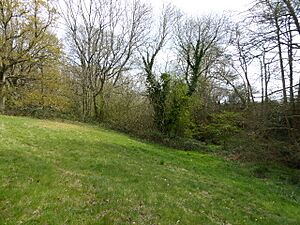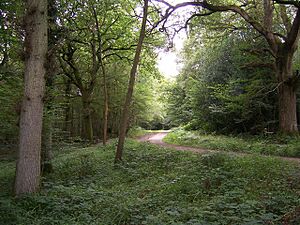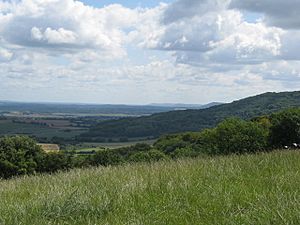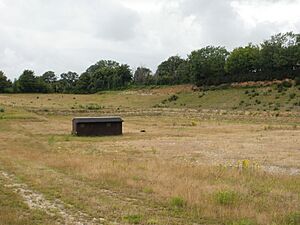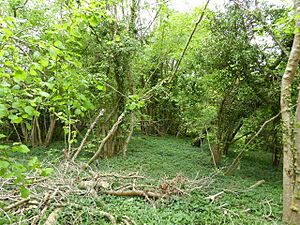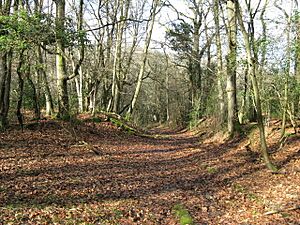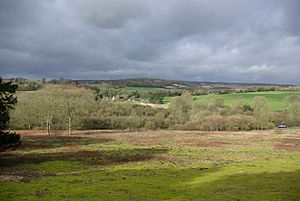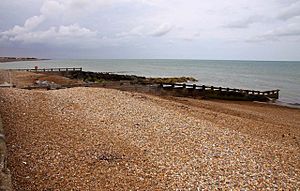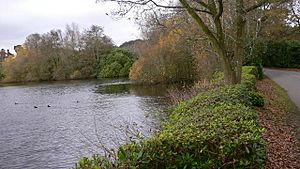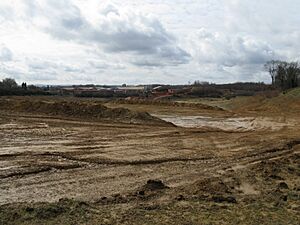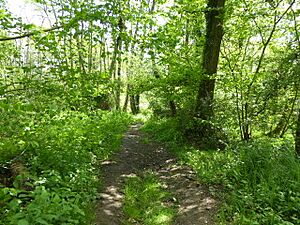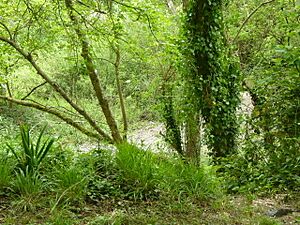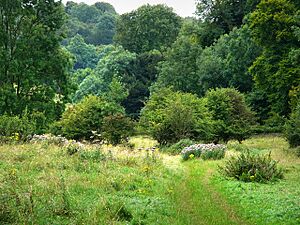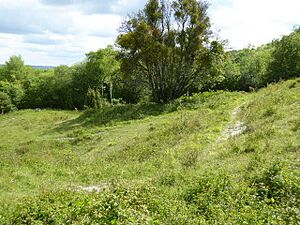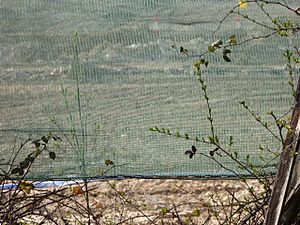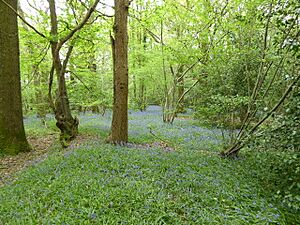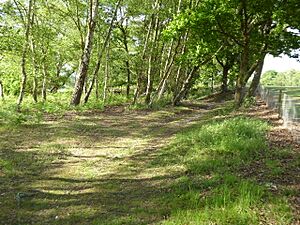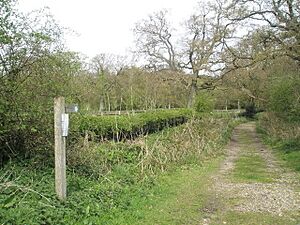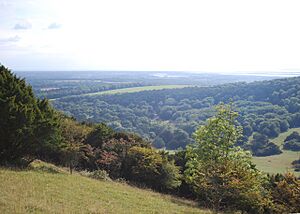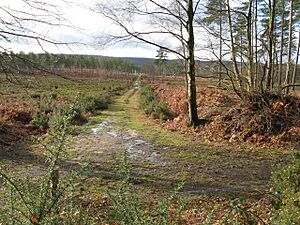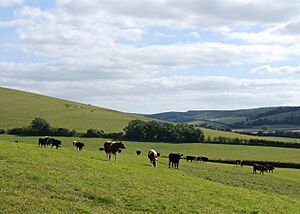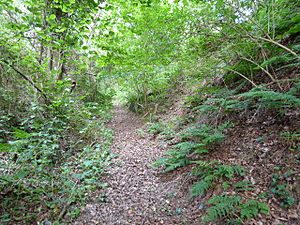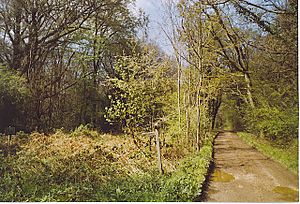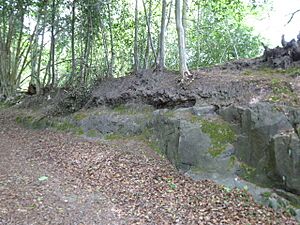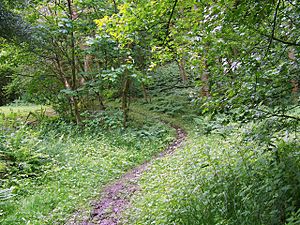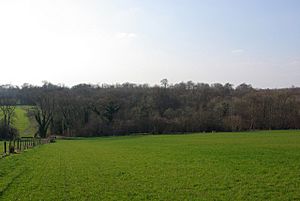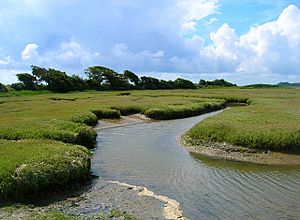List of Sites of Special Scientific Interest in West Sussex facts for kids
West Sussex is a county in south-east England, home to about 780,000 people. Its main town is Chichester. In the north, you'll find heavy clays and sands of the Weald. The chalk hills of the South Downs stretch across the middle, and a flat coastal area runs down to the English Channel in the south.
Contents
- What are Sites of Special Scientific Interest (SSSIs)?
- Understanding the Special Sites
- West Sussex's Amazing SSSIs
- Adur Estuary
- Amberley Mount to Sullington Hill
- Amberley Wild Brooks
- Ambersham Common
- Arun Banks
- Arundel Park
- Beeding Hill to Newtimber Hill
- Bognor Common Quarry
- Bognor Reef
- Bracklesham Bay
- Buchan Hill Ponds
- Burton Park
- Chanctonbury Hill
- Chantry Mill
- Chapel Common
- Chichester Harbour
- Chiddingfold Forest
- Cissbury Ring
- Clayton to Offham Escarpment
- Climping Beach
- Coates Castle
- Coneyhurst Cutting
- Coppedhall Hanger
- Cow Wood and Harry's Wood
- Duncton to Bignor Escarpment
- Eartham Pit, Boxgrove
- East Dean Park Wood
- Ebernoe Common
- Fairmile Bottom
- Felpham
- Forest Mere
- Freshfield Lane
- Fyning Moor
- Halnaker Chalk Pit
- Harting Downs
- Heyshott Down
- Horton Clay Pit
- House Copse
- Hurston Warren
- Iping Common
- Kingley Vale
- Lavington Common
- Levin Down
- Marehill Quarry
- The Mens
- Mills Rocks
- Northpark Copse to Snapelands Copse
- Pads Wood
- Pagham Harbour
- Parham Park
- Park Farm Cutting
- Perry Copse Outcrop
- Philpot's and Hook Quarries
- Pulborough Brooks
- Rake Hanger
- Rook Clift
- Selsey, East Beach
- Shillinglee Lake
- Singleton and Cocking Tunnels
- Slinfold Stream and Quarry
- St Leonard's Forest
- St Leonard's Park Ponds
- Stone Hill Rocks
- Sullington Warren
- Treyford to Bepton Down
- Turners Hill
- Upper Arun
- Wakehurst and Chiddingly Woods
- Waltham Brooks
- Warnham
- West Dean Woods
- West Harting Down
- West Hoathly
- Wolstonbury Hill
- Woolbeding and Pound Commons
- Woolmer Forest
- Worth Forest
- See also
- Sources
What are Sites of Special Scientific Interest (SSSIs)?
Sites of Special Scientific Interest, or SSSIs (pronounced "S-S-S-Is"), are places in England that are really important for their wildlife or geology. Think of them as nature's treasures! Natural England, a group that protects England's natural environment, chooses these sites. Once a place is an SSSI, it gets special legal protection to keep it safe for future generations.
As of July 2019, West Sussex has 77 SSSIs. Most of these (53) are special for their plants and animals (biological interest). Some (18) are important for their rocks and landforms (geological interest), and a few (6) are special for both! Many of these sites also have other important titles, like being a Special Area of Conservation or a National Nature Reserve.
Understanding the Special Sites
When we talk about these special sites, you might see some abbreviations. Here's what they mean:
What makes a site special?
- B = The site is important for its plants and animals (biological interest).
- G = The site is important for its rocks, fossils, or landforms (geological interest).
Can you visit?
- FP = You can only access footpaths that go through the site.
- No = There is no public access to the site.
- PP = You can visit parts of the site.
- Yes = You can visit all or most of the site.
Other Important Classifications
Some SSSIs have extra special titles:
- GCR = Geological Conservation Review site: These sites are super important for understanding Earth's history.
- LNR = Local nature reserve: These are places protected by local councils for nature and people to enjoy.
- NCR = Nature Conservation Review site: These are top sites for wildlife in Britain.
- NNR = National nature reserve: These are the most important places for wildlife and geology in England.
- Ramsar = Ramsar site: These are internationally important wetland sites, usually for birds.
- SAC = Special Area of Conservation: These sites protect rare habitats and species across Europe.
- SM = Scheduled monument: These sites also protect historical or archaeological remains.
- SPA = Special Protection Area: These sites protect wild birds and their habitats across Europe.
- SWT = Sussex Wildlife Trust: This group helps manage and protect wildlife in Sussex.
- SYWT = Surrey Wildlife Trust: This group helps manage and protect wildlife in Surrey.
West Sussex's Amazing SSSIs
Here are some of the special places in West Sussex:
Adur Estuary
This estuary has big areas of saltmarsh, where plants like sea purslane and glasswort grow. It's also a very important feeding spot for birds like ringed plovers, redshanks, and dunlin.
Amberley Mount to Sullington Hill
This site has chalk grassland and scrub on the side of the South Downs. You can find unusual butterflies, moths, and snails here, including the rare adonis blue butterfly.
Amberley Wild Brooks
This area of wet grazing marsh has many rare insects, especially dragonflies. It's also a key spot for birds in winter, with lots of teal, shoveler, and Bewick’s swan. It's an NCR, Ramsar, SAC, SPA, and SWT site.
Ambersham Common
This common is mostly heathland with many different insects, including a very rare digger wasp. It also has bogs and wet woodlands, and rare birds like European nightjars, woodlarks, and Dartford warblers. It's an NCR site.
Arun Banks
This site includes a tidal part of the River Arun. It has many different plants like reed sweet grass and sea club-rush. The river banks also have wet grassland and woodlands.
Arundel Park
This old deer park on the South Downs has an ancient lake called Swanbourne Lake. It's one of the most important places in the country for insects, with 15 endangered species, including the field cricket.
Beeding Hill to Newtimber Hill
Most of this site on the South Downs is chalk grassland with many different flowering plants. It's important for insects like harvestmen. Devil's Dyke here is special for showing how dry chalk valleys were formed long ago. It's a GCR and NCR site.
Bognor Common Quarry
This quarry shows rocks from the Early Cretaceous period, about 145 to 100 million years ago. It's a GCR site.
Bognor Reef
This site has a beach, sand dunes, and marsh. It's home to the nationally endangered childing pink flower. It's also one of the few places with a full sequence of London Clay layers, important for plant fossils and tiny fossil insects. It's a GCR site.
Bracklesham Bay
This area has grazing pastures, shingle, salt marsh, and reed beds. It's important for breeding and wintering birds. It also has many fossils from 56 to 34 million years ago, including over 160 fish species. It's a GCR site.
Buchan Hill Ponds
This site has two ponds and wet woodland. The ponds are home to 17 types of dragonflies, including two rare ones: the hairy dragonfly and downy emerald. The woods have many ground plants.
Burton Park
This site includes a large pond, wet woodland, bog, and marshy grassland. It has many different insects, including three nationally rare species of snails and craneflies. It's also important for breeding water birds like water rails and great crested grebes. It's an LNR and SWT site.
Chanctonbury Hill
This site on the South Downs is mostly woodland with some chalk grassland. A dewpond here has great crested newts, which are protected. Over 60 types of breeding birds have been seen here. It's an SM site.
Chantry Mill
This site shows the best example of where the Gault and Folkestone Beds meet, dating back about 140 million years ago. It's a GCR site.
Chapel Common
Most of this common is dry heath, but it also has woodlands and grasslands. Heathland birds here include woodlarks, European nightjars, and Dartford warblers, which are important across Europe. It's an SM site.
Chichester Harbour
The harbour has many different habitats like mudflats, shingle, and saltmarsh. The mudflats are feeding grounds for huge numbers of birds like ringed plovers, grey plovers, and curlews. It's also important for its sand dunes and shingle. It's a GCR, LNR, NCR, Ramsar, SAC, and SPA site.
Chiddingfold Forest
This site has several areas of ancient woodland and conifer plantations. Over 500 types of butterflies and moths have been recorded, including rare and endangered ones. It's a SYWT site.
Cissbury Ring
This site was once a flint mine in the Stone Age and a large hillfort in the Iron Age. It has chalk grassland and neutral grassland, providing important homes for birds and butterflies. It's an SM site.
Clayton to Offham Escarpment
Much of this site is chalk grassland with many flowering plants like autumn gentian and orchids. It also has woodlands and a rich community of breeding birds. It's an SWT site.
Climping Beach
This beach has sand dunes behind a shingle beach, which is a rare habitat. The wet sands and muds are full of small creatures, providing food for wintering birds like sanderling. It's an LNR site.
Coates Castle
This site has the entire known population (about 200) in Britain of a special field cricket, which is a protected species.
Coneyhurst Cutting
This road cutting shows a thick layer of limestone from about 130 million years ago. It contains fossils of large freshwater snails. It's a GCR site.
Coppedhall Hanger
A stream runs through this site, showing layers of sand and silt from about 130 million years ago. It's a GCR site.
Cow Wood and Harry's Wood
This ancient woodland has streams in steep valleys, creating a warm, moist environment. 47 types of breeding birds have been recorded here, including wood warbler and lesser spotted woodpecker.
Duncton to Bignor Escarpment
This steep site on the South Downs has mature beech woodland and chalk grassland. It's home to the largest British population of a rare snail and several rare moths. It's an NCR and SAC site.
Eartham Pit, Boxgrove
The oldest human remains in Britain, from 500,000 years ago, were found here. Flint tools have also been discovered. It's a GCR site.
East Dean Park Wood
This is one of the few remaining dry, sheltered woods on chalk downland in the county. Over 100 types of woodland plants have been recorded, along with many lichens and mosses.
Ebernoe Common
This site has several areas of ancient woodland. It's nationally important for lichens (over 100 species) and fungi (seven rare species). It's also important for woodland birds and bats. It's an NCR, NNR, SAC, and SWT site.
Fairmile Bottom
This area has scrub, mature forest, and chalk grassland rich in different species. It has an "outstanding diversity of beetles" and butterflies like the white admiral. It's an LNR site.
Felpham
This short stretch of shoreline is one of only three places in Britain with plant fossils from the Paleocene period, right after the dinosaurs died out 66 million years ago. It's a GCR site.
Forest Mere
This site includes Folly Pond and surrounding woodland, heath, and bog. It's known for its amazing collection of 17 dragonfly species and 49 breeding birds.
Freshfield Lane
This working quarry shows rocks from the Early Cretaceous period, about 140 to 113 million years ago. It's important for studying ancient environments and geography. It's a GCR site.
Fyning Moor
This is a rare type of woodland with alder trees, rich in minerals. It has diverse plants and three nationally uncommon fly species.
Halnaker Chalk Pit
This chalk pit is important because it has about half of Britain's population of a rare and vulnerable plant called broad-leaved cudweed.
Harting Downs
This site has several chalk grassland valleys on the South Downs, along with scrub and old woodlands. It's important for insects, including a rare snail and two uncommon moths. It's an NCR and LNR site.
Heyshott Down
This site on the South Downs has rare chalk grassland, rich in plants, mosses, and liverworts. It's also important for spiders and harvestmen, including a spider found in only one other place in Britain. It's an NCR site.
Horton Clay Pit
This site shows a thick and important sequence of rocks from the Early Cretaceous period. It provides evidence of a large basin that influenced how sediments were laid down in the western Weald. It's a GCR site.
House Copse
This ancient wood was once managed for hornbeam and lime trees. The banks of a stream here have many different plants.
Hurston Warren
This site has wet and dry heath, bogs, woodland, and open water. One of the bogs is a "quaking bog," where plants float on water or peat. It has plants like round-leaved sundew and cranberry.
Iping Common
This is one of the richest heathland areas in the county. It has wet and dry heath, ponds, and woodlands. It's home to many insects and heathland birds like European nightjar and European stonechat. It's an LNR, NCR, and SWT site.
Kingley Vale
This reserve's yew woods are considered the best in Britain, with some trees thought to be over 500 years old. It also has chalk grassland rich in flowering plants and 37 types of butterflies. It's an NCR, NNR, SAC, and SM site.
Lavington Common
This site has wet and dry heath, acid grassland, and woodland. It has many different insects, especially spiders.
Levin Down
This area of chalk grassland and heath on the South Downs has a rich variety of plants like autumn gentian and quaking grass. It's an SWT site.
Marehill Quarry
This old quarry is important for its Marehill Clay, which dates back 145 to 100 million years ago. It has caves where several bat species, like Natterer's bat, hibernate. It's a GCR and SWT site.
The Mens
This large woodland area has many different breeding birds and rich lichen and fungal growths. It's home to many rare beetles and an endangered fly. All three British species of woodpecker breed here. It's an NCR, SAC, and SWT site.
Mills Rocks
This site has rock outcrops with rare plants, like reed fescue grass, found in only two places in southern England. The rocks also support many mosses and liverworts.
Northpark Copse to Snapelands Copse
This site is important for its mosses and liverworts, which are leftovers from a warmer, wetter period 5000 years ago.
Pads Wood
This ancient wood is mainly hazel and sweet chestnut. It has many lichens growing on the oak and ash trees, and a wide path with many flowering plants.
Pagham Harbour
This is a large area of salt marsh, mud flats, and shingle. It's nationally important for breeding birds and wintering wildfowl. It also has rare plants and insects, including the endangered sea anemone. It's a GCR, LNR, NCR, Ramsar, and SPA site.
Parham Park
This medieval deer park has a very rich collection of lichens, with 165 species recorded. It also has a large heronry and two rare beetles. It's an NCR site.
Park Farm Cutting
This site shows rocks from the Early Cretaceous period, 145 to 100 million years ago. It's the best place to find many different mollusc fossils. It's a GCR site.
Perry Copse Outcrop
This site dates back to the Early Cretaceous period. The steep banks of a stream show a 5-meter high section of sand, with 1-meter high fossils of ancient plants standing upright. It's a GCR site.
Philpot's and Hook Quarries
These quarries show rocks from the Early Cretaceous period, 145 to 100 million years ago. Philpot's Quarry has many dinosaur fossils, and both quarries have very old rock fragments. It's a GCR site.
Pulborough Brooks
These wet meadows have many ditches with rich aquatic plants and insects, including some rare ones. The site is internationally important for wintering wildfowl and many breeding birds like lapwing and barn owl. It's a Ramsar, SAC, and SPA site.
Rake Hanger
Oak trees grow on the steep slopes of this site, while alder trees are common at the wet bottom. It has lichens found in ancient woodlands and special plants growing on the banks of two ponds.
Rook Clift
A stream starts in this steep valley, which has ancient woodland. The canopy is dominated by a rare tree called large-leaved lime. It has many different snails, including a rare species. It's an SAC site.
Selsey, East Beach
This site shows layers of marine, estuary, and freshwater deposits from a warm period about 130,000 years ago. It has fossils of ancient animals like straight-tusked elephants and extinct rhinoceroses. It's a GCR site.
Shillinglee Lake
This lake is an SSSI because it has four nationally uncommon plants. One of these is found in only ten places in the country!
Singleton and Cocking Tunnels
These old railway tunnels are the fifth most important site for hibernating bats in Britain. They are the only known place in the country for the greater mouse-eared bat. It's an SAC site.
Slinfold Stream and Quarry
This site shows rocks from the Early Cretaceous period, about 130 million years ago. It has fossils of ancient horsetail plants standing upright, suggesting they grew in a shallow freshwater swamp. It's a GCR site.
St Leonard's Forest
Much of this forest is deciduous woodland with oak, birch, and beech trees. The humid climate in a narrow valley has allowed mosses and liverworts to survive, showing the woodland has been there for 5,000 years. Rare butterflies like the purple emperor can be found here.
St Leonard's Park Ponds
These ponds and nearby woodland are home to many different dragonflies and damselflies, including some rare ones. The banks have special plants, including the nationally rare yellow centaury.
Stone Hill Rocks
This site is a good example of sandstone cliffs found in mid-Sussex, showing rocks from the Early Cretaceous period, 145 to 100 million years ago. It's important for studying how these rocks were formed. It's a GCR site.
Sullington Warren
Most of this site is dry heath, but it also has wet heath, scrub, and woodland. The wet heath has insect-eating plants like round-leaved sundew. Woodland birds here include all three British species of woodpecker. It's an SM site.
Treyford to Bepton Down
This site has five areas of steep chalk grassland and yew woodland on the South Downs. The grassland is rich in plant species, including rare herbs and orchids.
Turners Hill
This former quarry (now filled in) showed rocks from the Early Cretaceous period, about 145 to 100 million years ago. It provided excellent views of the sandstone layers. It's a GCR site.
Upper Arun
This 13-kilometer stretch of the River Arun has many river plants. It's an amazing place for breeding dragonflies, including the nationally rare scarce chaser.
Wakehurst and Chiddingly Woods
These woods have steep valleys formed by streams cutting through sandstone, showing rock outcrops. The valleys have a warm, moist climate, with many ferns, mosses, liverworts, and lichens. It's a GCR and NCR site.
Waltham Brooks
This is one of the few remaining grazing marsh areas in the county, with many aquatic plants, including a nationally rare species. Many bird species spend the winter here, including Bewick’s swan and teal. It's a Ramsar, SPA, and SWT site.
Warnham
This site shows rocks from the Early Cretaceous period, about 130 million years ago. It has fossil plants from both freshwater and salty water environments. It's a GCR site.
West Dean Woods
These woods have records going back to the 1500s. The ground is rich in flowering plants, including wild daffodils. Many mosses and liverworts have been recorded, along with rare hoverflies that live on dead wood. It's an SWT site.
West Harting Down
This site is mainly mature yew forest on the chalk of the South Downs. It also has chalk grassland with plants like rock rose and different grasses.
West Hoathly
This working quarry shows clays from the Early Cretaceous period, 145 to 100 million years ago. It's important for understanding the ancient environment of the area. It's a GCR site.
Wolstonbury Hill
This steep site is mostly grassland with areas of beech and oak woodland. The chalk grassland is rich in species, including rare plants like round-headed rampion and several types of orchids. It's an SM site.
Woolbeding and Pound Commons
These commons have wet and dry heath, woodland, and ponds. They are home to many rare insects, including bees, wasps, and beetles. The site also provides a home for three rare birds: woodlark, nightjar, and Dartford warbler.
Woolmer Forest
This forest has nationally important heathland plants, including rare ones like tower mustard. It has many different insects and large areas of open water. It's the only site in the country known to have all twelve native species of reptiles and amphibians! It's an NCR, SAC, and SPA site.
Worth Forest
This ancient wood is in a steep valley formed by a stream. The wet valley bottom has carpets of sphagnum moss, while the upper slopes have many different mosses, liverworts, and lichens.
See also
- List of Local Nature Reserves in West Sussex
- Sussex Wildlife Trust
Sources


